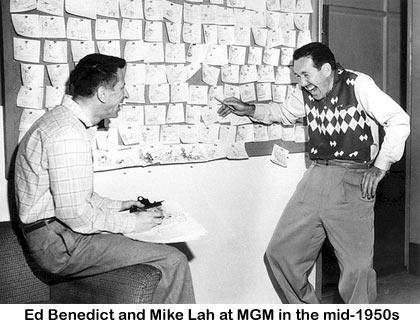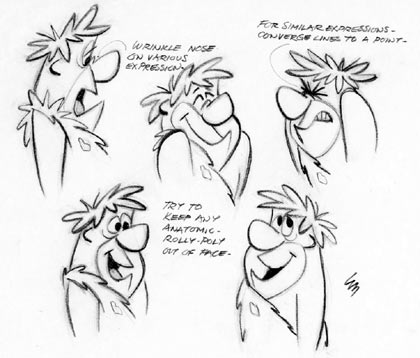

Ed Benedict (1912-2006), RIP

Earlier this evening I received word from Van Partible and David Sheldon that animation legend Ed Benedict passed away in his sleep this past Monday at age 94. Per Ed’s wishes, there will be no service of any kind. He will be cremated and his ashes scattered over Carmel Bay, where his wife Alice’s ashes were also spread.
It’s a difficult time to be an animation fan as slowly the last of the greats of animation’s Golden Age have been dying. With Ed gone, only a handful of the industry’s giants remain, including Joe Barbera, Bill Melendez, Bill Littlejohn, Ollie Johnston, Jack Zander, and a few others. But back to Ed, his career was long and illustrious, not to mention fairly unconventional, including an attempt to start his own studio in the 1930s and involvement in very early TV commercials. He began at Disney in 1930 and animated on the studio’s early films like THE CHINA PLATE and BLUE RHYTHM. In 1933, he moved to Universal where he worked on Walter Lantz’s Oswald shorts. For much of the 1930s he was at Universal, though he also worked a stint at Mintz and briefly started his own studio, Benedict-Brewer, in partnership with Jerry Brewer. He returned to Disney in the early-1940s where he did layout on various industrial/educational films like ENVIROMENTAL SANITATION and DAWN OF BETTER LIVING. During this time, he also received his first and only Disney credit as a layout artist on MAKE MINE MUSIC. In the mid-1940s, he entered the world of TV commercial animation at Paul Fennell’s Cartoon Films, which is where he first began exploring the more modernized approach to drawing that would serve him well in the following decades.

In 1952, Benedict was recruited by his former Universal colleague Tex Avery to become Avery’s lead layout artist and designer at MGM. Ed designed a number of Avery’s classic shorts including DIXIELAND DROOPY, FIELD AND SCREAM, THE FIRST BAD MAN, DEPUTY DROOPY and CELLBOUND. After Avery left MGM, Benedict continued working at the studio on the Mike Lah-directed Droopy shorts, while also freelancing for Avery on TV commercials at Cascade. While at MGM, Ed’s work caught the eyes of Bill Hanna and Joe Barbera. Hanna asked Benedict to design a dog and a cat for a TV project, which turned out to be the first Hanna-Barbera TV series THE RUFF AND REDDY SHOW. During the late-1950s and early-1960s, Benedict became the primary designer for Hanna-Barbera and he designed most of the studio’s early stars including Yogi Bear, Huckleberry Hound, Quick Draw McGraw, The Flintstones, Snagglepuss and countless others. It would not be an exaggeration to say that a large part of H-B’s success in TV animation is owed to Benedict’s incredibly appealing and fun character designs. Ed moved to Carmel, California in the 1960s and continued freelancing for various studios during the 1960s and ’70s before retiring.
Ed’s passing is made a litle easier knowing that he was appreciated and recognized for his accomplishments during his lifetime, which is something that can’t be said for a lot of other animation artists. Ed has countless admirers throughout the animation and illustration communities including John Kricfalusi, David Sheldon, Van Partible, Jordan Reichek, Craig Kellman and Gabe Swarr, to name but a few. The influence of his work is readily apparent in countless cartoons being created today, a testament to the lasting quality of his work.
On a personal note, I have to say that Ed was certainly one of the most memorable of the artists that I’ve interviewed over the years. He was a study in contrasts. He made it very clear that he disliked the Hanna Barbera TV cartoons, the work that he was most known for, and that he didn’t care particularly that people liked his work so much. And yet, you could hardly find a person more passionate when it came to discussing art, design and animation. I had the opportunity to visit Ed a few times in northern California, and I can’t ever remember a visit lasting less than ten hours. Ed would keep you enthralled with a fascinating range of opinions on every conceivable topic from why organs sound better than pianos to lamenting the deteriorated state of contemporary car design. On the surface, Ed might have seemed indifferent, but his theories on such a variety of topics revealed years of careful observation and analysis of his surroundings. It’s only fitting that the designer of so many classic animation characters would himself have such a depth of personal character.
If you have personal remembrances of Ed Benedict or were influenced by his work, please feel free to leave comments in this Cartoon Modern post and I’ll try to make sure it’s forwarded to his family.

Links to Ed Benedict on the Web
John Kricfalusi writes about why he likes Ed’s work so much
An appreciation of Ed by animation director Jordan Reichek, originally published in ANIMATION BLAST #8
A Flickr set that has scans of a 5-page Ed Benedict interview conducted by John K.
Online scans of my article in ANIMATION BLAST #8 where I interviewed John K. about Ed’s work.
A few 1950s Ed Benedict designs from my other blog Cartoon Modern

